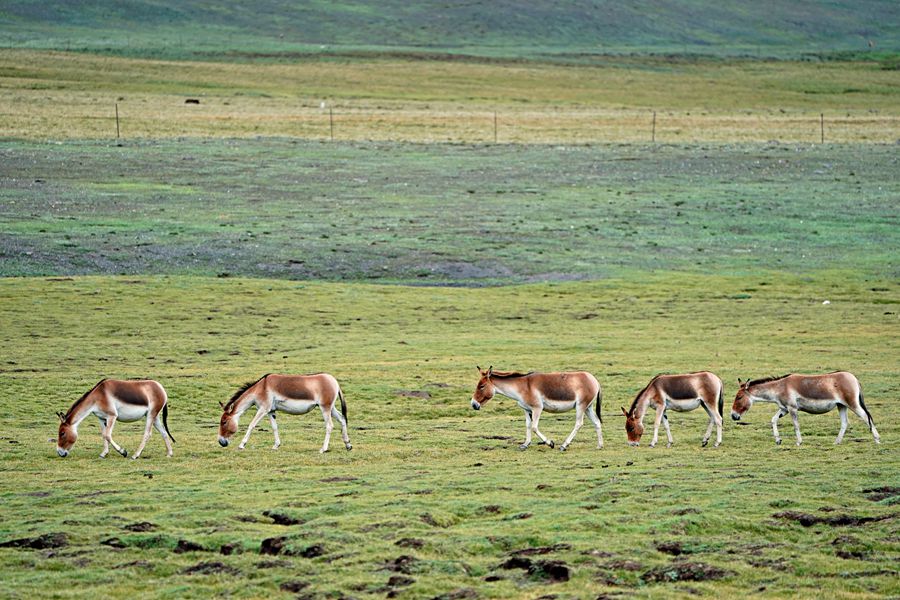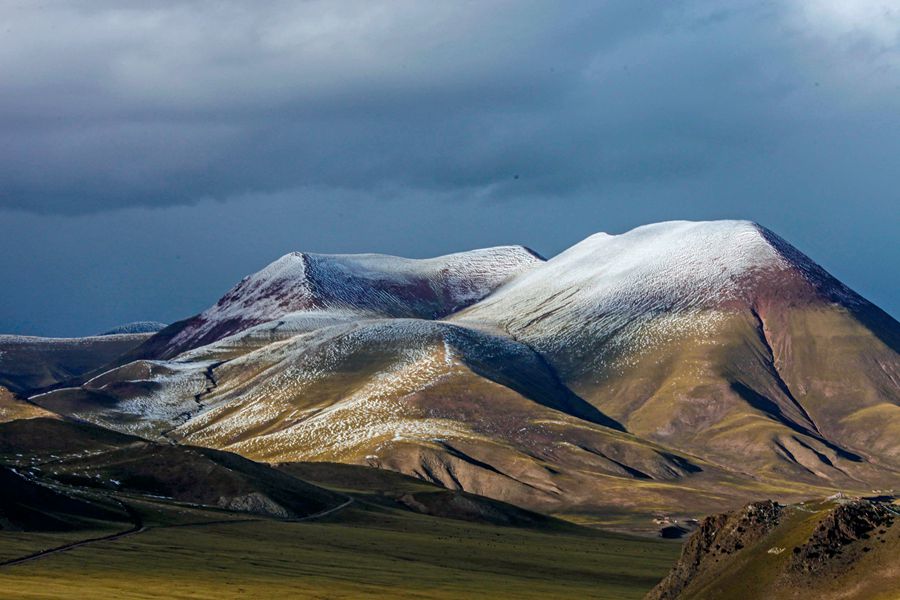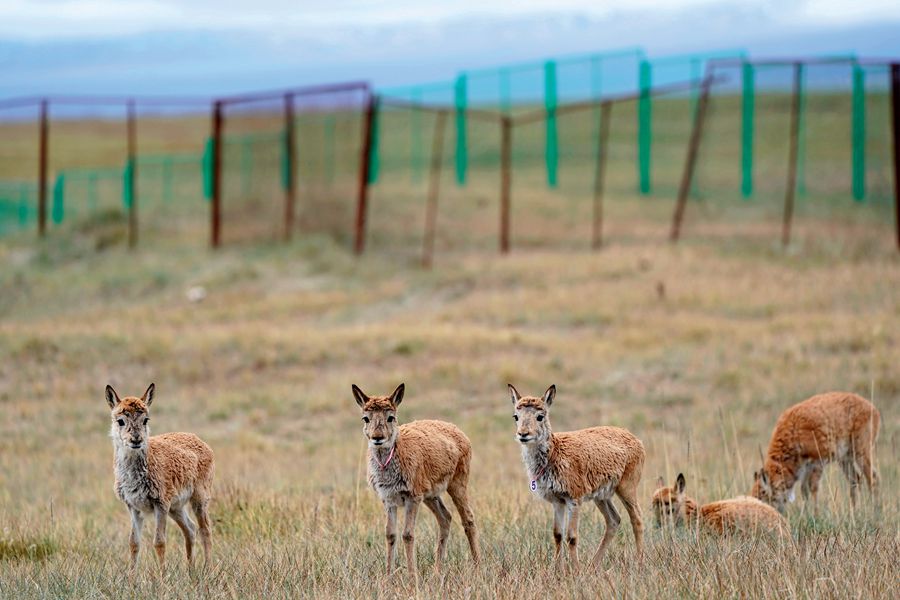HOH Xil Nature Reserve, “Hoh Xil” meaning ‘beautiful girl’ in Mongolian, is located in the hinterland of the Qinghai-Tibet Plateau. Because of its harsh natural environment, no people live here. Therefore it’s also known as the “forbidden zone for humans” or “mysterious land.” It is one of the regions on earth that humans have little knowledge of, thus preserving it as an untouched natural paradise.
Located in the northeastern corner of the Qinghai-Tibet Plateau, Hoh Xil Nature Reserve covers a large area of mountains and grassland at an altitude of more than 4,500 meters above sea level. It is currently a nature reserve with an excellently preserved primitive ecological environment, as well as one of the largest and highest nature reserves with most abundant wildlife resources in China.
In 2017, Hoh Xil Nature Reserve was included in the World Heritage List. The nominated area is in the territory of Zhidoi County and Qumarleb County in Yushu Tibetan Autonomous Prefecture of west China’s Qinghai Province. It covers 37,000 square kilometers, and the buffer area is 23,000 square kilometers, making the total area about 60,000 square kilometers.
Rolling sand dunes, lofty snow-capped mountains, clear blue lakes, dark green marshes, thriving wild species, along with gentle breezes and floating clouds, constitute this distinctive paradise. It is a forbidden zone for human beings but a paradise of life. It is the mysterious place of scientific investigation, and also the secret world that allures explorers again and again to visit its remote corners.
Quiet and beautiful scenery of Hoh Xil.
Modern science holds that the Qinghai-Tibet Plateau emerged as the result of crustal movement.
About 300 million years ago, Hoh Xil was still an ocean. The subsequent crustal movement closed the ocean, resulting in the sharp rise of the Qinghai-Tibet Plateau. With wide sedimentary basins laying between the mountains and crisscrossing peaks, a vast wilderness Hoh Xil came into being. Complex geological movements shaped Hoh Xil into a high plateau alpine landform integrating alpine, wide valleys, glaciers, hot springs, rivers, and lakes.
The average altitude of Hoh Xil is 5,000 meters, making it one of the highest spots in the Qinghai-Tibet Plateau. High altitude creates quite a chilly world, with temperatures reaching as low as -46.2˚C. More than 90 percent of the land is covered by permafrost, the thickness of which is 80-120 meters. There are huge glaciers on the high mountains, as well as other glaciers widely distributed throughout the reserve. Glaciers and permafrost form huge solid reservoirs. The glaciers and snow covered mountains are the source that nourish the Yangtze, Yellow and Lancang rivers.
Hoh Xil Nature Reserve is characterized by its high number of lakes. According to statistics, there are 107 lakes with an area of more than one square kilometer, six lakes with an area of over 200 square kilometers, and more than 7,000 lakes with an area of less than one square kilometer. Consequently, it is recognized as “the land of a thousand lakes.” The scattered plateau lakes and well-preserved plateau planation constitute the rare scenery. The harsh natural conditions and few inhabitants render the Qinghai Hoh Xil the best place to maintain the original ecological environment and unique natural landscape of the plateau.
The Tibetan wild donkey is a national first-class protected animal.
The unique geographical environment and climatic characteristics of the hinterland of the Qinghai-Tibet Plateau have created a distinctive ecosystem in the high altitude region, which records the history of the development of the earth and the evolutionary process of life. The blending and contrasting six colors of the vast expansion of blue sky, the white of the snowy mountains, the yellow of the earth, the green of the lakes, the grey of the alpine, the brown of antelopes make the region a feast to the beholder. The region is decorated with towering snow-capped mountains, magnificent glaciers, crystal lakes, spreading wilderness, and a vast Gobi desert. All year round, Hoh Xil maintains a kind of desolate but pure beauty. The vast grassland desert sets against the pure mountain lake, and wild flowers in summer meadows fill the wilderness with vitality. During winter months, the gleaming white snow seems to connect the sky and the earth with a seamless line. In addition to this, there are many peculiar natural landscapes, such as valley glaciers, frozen mounds, colorful plateau lakes, blooming “salt flowers” on the edge of salt lakes, as well as boiling springs under glaciers, with water temperatures of up to 91˚C, all of which are unique tourist attractions of Hoh Xili.
Although the natural conditions of Hoh Xil Nature Reserve are harsh, making it impossible for humans to stay long here, it is a paradise teeming with wildlife. From small animals such as pikas, plateau rabbits, and horned larks, to hoofed animals like Tibetan antelopes, Tibetan gazelles, and Tibetan wild donkeys, as well as predators including falcons, lynxes, and wolves, they are the real masters of this wilderness.
People became aware of the existence of Hoh Xil because of the Tibetan antelope and the “Wild Yak Team” formed to protect this animal. A representative animal of the Qinghai-Tibet Plateau, the Tibetan antelope is known as the plateau elf. With a light, flying stride, they run around in groups on the horizon after the snow comes, bringing to life the vast expanse of wilderness. Hoh Xil Nature Reserve is the main breeding ground of the Tibetan antelope, which is vital for maintaining its migration route. The whole migration route of Tibetan antelopes between the headwaters of the “Three Rivers” and Hoh Xil Nature Reserve is preserved in the region, supporting the uninterrupted migration of Tibetan antelopes. Starting from May every year, tens of thousands of Tibetan antelopes from Xinjiang, Tibet, and Qinghai come to Zonag Lake in Hoh Xil to give birth. By August, female antelopes return with their young calves and complete their migration process. Now what is the reason behind this? What do the Tibetan antelopes rely on to find their way? This is still clouded in mystery.

A few wondering-alone or injured Tibetan antelopes that have been rescued throughout the year in the wildlife rescue center behind the conservation station, Qinghai Province.
In 1995, the Qinghai provincial government established a provincial nature reserve to protect rare wildlife, plants, and habitats, such as the Tibetan antelope, wild yak, Tibetan wild donkey, and Tibetan gazelle. In 1997, it was upgraded to a national nature reserve. Through years of tireless efforts to combat poaching and establish nature reserves, the number of Tibetan antelopes has gradually recovered. In 2016, the International Union for Conservation of Nature (IUCN) marked the Tibetan antelope from “endangered” to “near–threatened.”
The perfect combination of the alpine ecosystem and plateau wetland ecosystem makes Hoh Xil Nature Reserve an unparalleled paradise of biodiversity. There are 210 species distributed throughout the region, 72 of which are endemic to the Qinghai-Tibet Plateau. There are more than 230 species of wildlife, including more than 20 species under first class and second class special state protection, 12 of which are endemic to the Qinghai-Tibet Plateau. In addition to Tibetan antelopes, there are yaks that brave the piercing chilly winds to cross the thick snow, wolves watching for prey in the snowy wilderness, wild donkeys, white-lipped deer, brown bears and other wildlife unique to that region. With the increasing efforts of ecological environment protection in recent years, the number of wildlife population in Hoh Xil Nature Reserve has greatly increased. The harmonious coexistence of man and nature is the most beautiful scenery on the plateau.
A Journey Reserved for the Brave
Conquering nature and challenging limits have always been the ultimate dream of mankind. In the past, many people have tried to cross the unmanned zone but lost their lives. Today, there are still new challengers to continue the journey of the brave. However, the ecological environment of the plateau is fragile, and any traces left by human beings will take a long time to fade away. In order to protect the ecological balance of the plateau and the safety of tourists, in November 2017, Hoh Xil of Qinghai, the Altun Mountains in Xinjiang and Qiangtang in Tibet issued a joint announcement, prohibiting all units and individuals from entering the reserve illegally. For travelers who want to experience the natural beauty of Hoh Xil Nature Reserve, they can visit the buffer zone outside the reserve.
The Tanggula Mountain Pass is the demarcation line between Qinghai and Tibet, and the highest point of the Qinghai-Tibet Highway. It is known as the “snow storehouse” due to the wind and snow cover all year round. There are monuments and landmarks erected on the mountain pass, which is the only way to enter Tibet along the Qinghai-Tibet Highway. This is the headstream of the Yangtze River. At the foot of the mountains is the unmanned zone of Hoh Xil Nature Reserve, which is a comfortable pasture for endangered wildlife such as Tibetan antelopes.
The Kunlun Mountains Pass is the only way to reach Tibet from provinces of Qinghai and Gansu. It is also a major pass on the Qinghai-Tibet Highway and the only way for automobiles to pass through to explore the world’s roof. The Kunlun Mountains are a symbol of the Chinese nation and the cradle of Chinese myths and legends. Although the vast plateau permafrost layer in the Kunlun Mountains Pass remains frozen all the year round, green grass grows in the meadow on the surface of the permafrost layer. During midsummer every year, bright and dazzling wildflowers bloom, presenting viewers with an enchanting view.
Golmud euphrates poplar forest is located in the northwest part of the Altenqoke Grassland, about 60 kilometers away from the urban area of Golmud, and is the highest euphrates poplar forest in the world. It borders the towering Kunlun Mountains in the south, and is next to the vast Gobi salt beach in the north. Every October, the colors of the euphrates poplar forest turn from a deep green to golden, looking like a burning flame against the backdrop of a vast sky. It seems to dye the whole desert with gold, impressing the viewer with the beauty of nature and the tenacity of life.
The Ulan Moron River is located in the Tanggula Town, in the southern region of Golmud City, Qinghai Province. It is the west source of the Yangtze River. The source of the Ulan Moron River is Geladandong glacier, the main peak of the Tanggula Mountains. The scenery here is extremely magnificent, with snowy mountains and ice-covered peaks, endless grasslands, blue skies and white clouds reflecting on the river surface, all constituting a relaxing and pleasant natural environment. The bridge across the Yangtze River headwaters of the Ulan Moron River was the first bridge built in the upper reaches of the Yangtze River, subsequently giving it the name, “The First Bridge over the Yangtze River.”
Qarhan Salt Lake, located in Golmud City, Qinghai Province, is the largest salt lake in China and one of the most famous inland salt lakes in the world. The green plants around the lake have a difficult time growing, but the lake generates the magical “salt flowers” which glitter like jade and have varied shapes. “Salt flower” is the name of a beautiful crystal that is formed when salt crystallizes in a salt lake. “Salt flowers” here resemble pearls, corals, pavilions, birds or animals. They gather in the salt lake in clusters, turning the lake into a beautiful and dazzling fairyland. Due to the constant evaporation of water in the lake, a hard salt cap was formed over the salt lake. The Qinghai-Tibet Railway and the Qinghai-Tibet Highway were built directly on the salt cap. In fact, the highway is like a bridge floating on the brine, a salt bridge resembling a jade belt, with no guardrail, no pier and no running water. The surface of the road is smooth and straight. Salt Bridge (road) splits the salt lake in half from the middle, quite an amazing scene. One can’t help admiring the human intelligence in making such an architecture.


